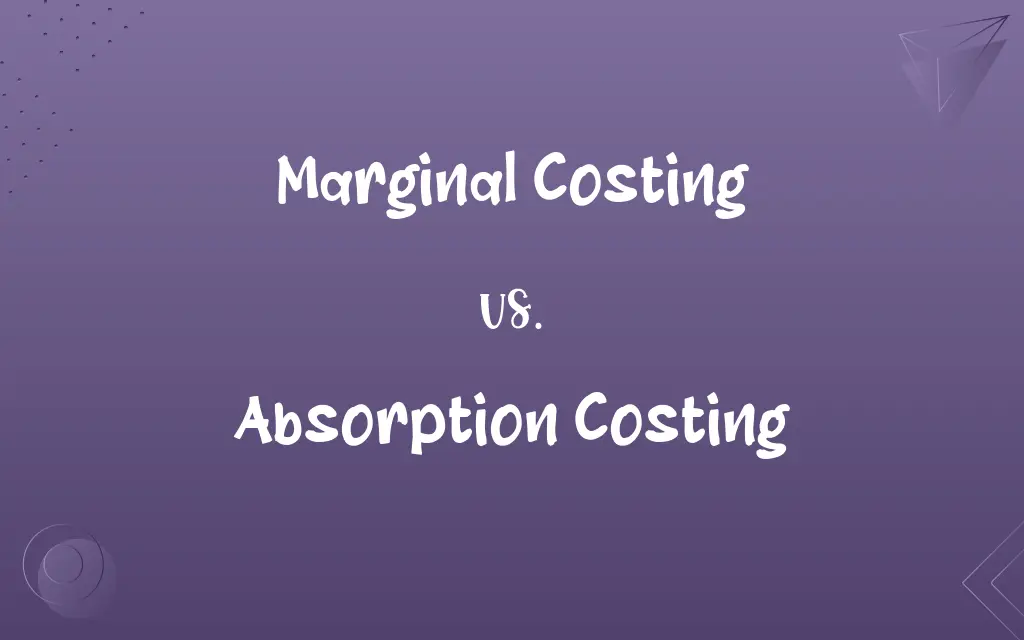Marginal Costing vs. Absorption Costing: Know the Difference

By Shumaila Saeed || Published on January 9, 2024
Marginal Costing considers only variable costs for product costing and decision-making. Absorption Costing includes both fixed and variable costs in product costing.

Key Differences
Marginal Costing is a costing technique where only variable costs are charged to cost units, and fixed costs are treated as period costs. In contrast, Absorption Costing allocates all manufacturing costs (both fixed and variable) to products, spreading fixed costs over total units produced.
Shumaila Saeed
Jan 09, 2024
In Marginal Costing, profit reporting is influenced mainly by sales volume, as fixed costs remain constant regardless of production levels. However, in Absorption Costing, both production and sales volumes can affect profit reporting, as fixed costs are distributed across units produced.
Shumaila Saeed
Jan 09, 2024
Marginal Costing is useful for short-term decision-making as it highlights variable costs, which are controllable in the short term. Absorption Costing, by considering all costs, provides a more comprehensive view, crucial for long-term decision-making and pricing strategies.
Shumaila Saeed
Jan 09, 2024
Marginal Costing can lead to under-recovery of fixed costs in periods of low production, while high production may result in over-recovery. In contrast, Absorption Costing evens out the impact of fixed costs, as they are absorbed into product costs regardless of production levels.
Shumaila Saeed
Jan 09, 2024
With Marginal Costing, inventory valuation excludes fixed overheads, potentially leading to lower inventory values on the balance sheet. In Absorption Costing, inventory valuation includes fixed overheads, often resulting in higher reported inventory values.
Shumaila Saeed
Jan 09, 2024
ADVERTISEMENT
Comparison Chart
Cost Components Considered
Only variable costs
Both fixed and variable costs
Shumaila Saeed
Jan 09, 2024
Impact on Profit Reporting
Influenced by sales volume
Influenced by both production and sales volumes
Shumaila Saeed
Jan 09, 2024
Suitability
Better for short-term decisions
Better for long-term decisions and pricing
Shumaila Saeed
Jan 09, 2024
Fixed Cost Treatment
Treated as period costs, not included in inventory
Allocated to products, included in inventory valuation
Shumaila Saeed
Jan 09, 2024
Inventory Valuation
Lower, as fixed costs are excluded
Higher, as fixed costs are included
Shumaila Saeed
Jan 09, 2024
ADVERTISEMENT
Marginal Costing and Absorption Costing Definitions
Marginal Costing
Marginal Costing helps in determining the contribution of each product to profit.
Using marginal costing, the firm calculated each product's contribution margin.
Shumaila Saeed
Dec 15, 2023
Absorption Costing
Absorption Costing provides a comprehensive view of total production costs.
Absorption costing helped the company in long-term pricing strategy.
Shumaila Saeed
Dec 15, 2023
Marginal Costing
Marginal Costing treats fixed costs as period expenses, not product costs.
In marginal costing, the monthly rent was treated as a period expense.
Shumaila Saeed
Dec 15, 2023
Absorption Costing
Absorption Costing is suitable for financial reporting and meeting external requirements.
For regulatory compliance, the firm adopted absorption costing in its financial statements.
Shumaila Saeed
Dec 15, 2023
Marginal Costing
Marginal Costing is used to assess the impact of variable costs on total costs.
Marginal costing revealed the cost per unit decreased with increased production.
Shumaila Saeed
Dec 15, 2023
ADVERTISEMENT
Absorption Costing
Absorption Costing is a costing method that includes all manufacturing costs in product costs.
Absorption costing showed higher product costs due to the inclusion of fixed overheads.
Shumaila Saeed
Dec 15, 2023
Marginal Costing
Marginal Costing is a costing method that includes only variable costs in product costs.
The company used marginal costing to quickly adjust pricing during market fluctuations.
Shumaila Saeed
Dec 15, 2023
Absorption Costing
Absorption Costing includes both fixed and variable costs in inventory valuation.
The inventory value was higher under absorption costing due to fixed cost inclusion.
Shumaila Saeed
Dec 15, 2023
Marginal Costing
Marginal Costing focuses on variable costs for decision-making and analysis.
Marginal costing helped the company identify cost-saving opportunities in production.
Shumaila Saeed
Dec 15, 2023
Absorption Costing
Absorption Costing allocates fixed costs over all units produced.
The company's absorption costing method spread the factory rent across all products.
Shumaila Saeed
Dec 15, 2023
Repeatedly Asked Queries
Which costing method is more suitable for short-term decision-making?
Marginal Costing is more suitable for short-term decision-making.
Shumaila Saeed
Jan 09, 2024
What is the key difference in cost treatment between Marginal and Absorption Costing?
Marginal Costing includes only variable costs, while Absorption Costing includes both fixed and variable costs.
Shumaila Saeed
Jan 09, 2024
Can Marginal Costing lead to fluctuations in profit reporting?
Yes, profits can fluctuate more under Marginal Costing based on sales volume.
Shumaila Saeed
Jan 09, 2024
How do Marginal and Absorption Costing affect pricing strategies?
Absorption Costing provides a more comprehensive cost basis for pricing, while Marginal Costing focuses on variable costs.
Shumaila Saeed
Jan 09, 2024
Is Absorption Costing generally accepted for financial reporting?
Yes, Absorption Costing is widely accepted for external financial reporting.
Shumaila Saeed
Jan 09, 2024
Can Marginal Costing be used for long-term financial planning?
Marginal Costing is less suitable for long-term planning due to its focus on variable costs.
Shumaila Saeed
Jan 09, 2024
Does Marginal Costing consider fixed costs for product pricing?
No, Marginal Costing does not include fixed costs in product pricing.
Shumaila Saeed
Jan 09, 2024
Which costing method provides a clearer picture of per-unit cost?
Absorption Costing provides a more comprehensive per-unit cost picture.
Shumaila Saeed
Jan 09, 2024
Which method is better for evaluating production efficiency?
Absorption Costing is better for evaluating overall production efficiency.
Shumaila Saeed
Jan 09, 2024
How does Absorption Costing affect inventory valuation?
Absorption Costing increases inventory valuation by including fixed costs.
Shumaila Saeed
Jan 09, 2024
Can both methods be used simultaneously for internal management?
Yes, a combination of both methods can provide a balanced view for internal management.
Shumaila Saeed
Jan 09, 2024
How do Marginal and Absorption Costing impact cost control?
Marginal Costing is better for controlling variable costs, while Absorption Costing provides a view of overall cost efficiency.
Shumaila Saeed
Jan 09, 2024
How does Marginal Costing affect contribution margin analysis?
Marginal Costing directly aids in contribution margin analysis by focusing on variable costs.
Shumaila Saeed
Jan 09, 2024
How does Absorption Costing handle overhead costs?
Absorption Costing spreads overhead costs over all units produced.
Shumaila Saeed
Jan 09, 2024
How does each method treat seasonal production variations?
Marginal Costing is more responsive to seasonal variations, while Absorption Costing smooths out such fluctuations.
Shumaila Saeed
Jan 09, 2024
Is Marginal Costing suitable for regulatory financial reporting?
Marginal Costing is less commonly used for external financial reporting due to its exclusion of fixed costs.
Shumaila Saeed
Jan 09, 2024
Which method is more straightforward for calculating break-even points?
Marginal Costing is more straightforward for calculating break-even points due to its focus on variable costs.
Shumaila Saeed
Jan 09, 2024
Does Absorption Costing help in cost-volume-profit analysis?
Absorption Costing can be used in cost-volume-profit analysis, but it may not be as direct as Marginal Costing.
Shumaila Saeed
Jan 09, 2024
Is Marginal Costing more flexible in changing market conditions?
Yes, Marginal Costing is more flexible and responsive to changes in market conditions.
Shumaila Saeed
Jan 09, 2024
Which costing method is better for analyzing the profitability of individual products?
Marginal Costing is often more effective for analyzing the profitability of individual products.
Shumaila Saeed
Jan 09, 2024
Share this page
Link for your blog / website
HTML
Link to share via messenger
About Author
Written by
Shumaila SaeedShumaila Saeed, an expert content creator with 6 years of experience, specializes in distilling complex topics into easily digestible comparisons, shining a light on the nuances that both inform and educate readers with clarity and accuracy.


































































